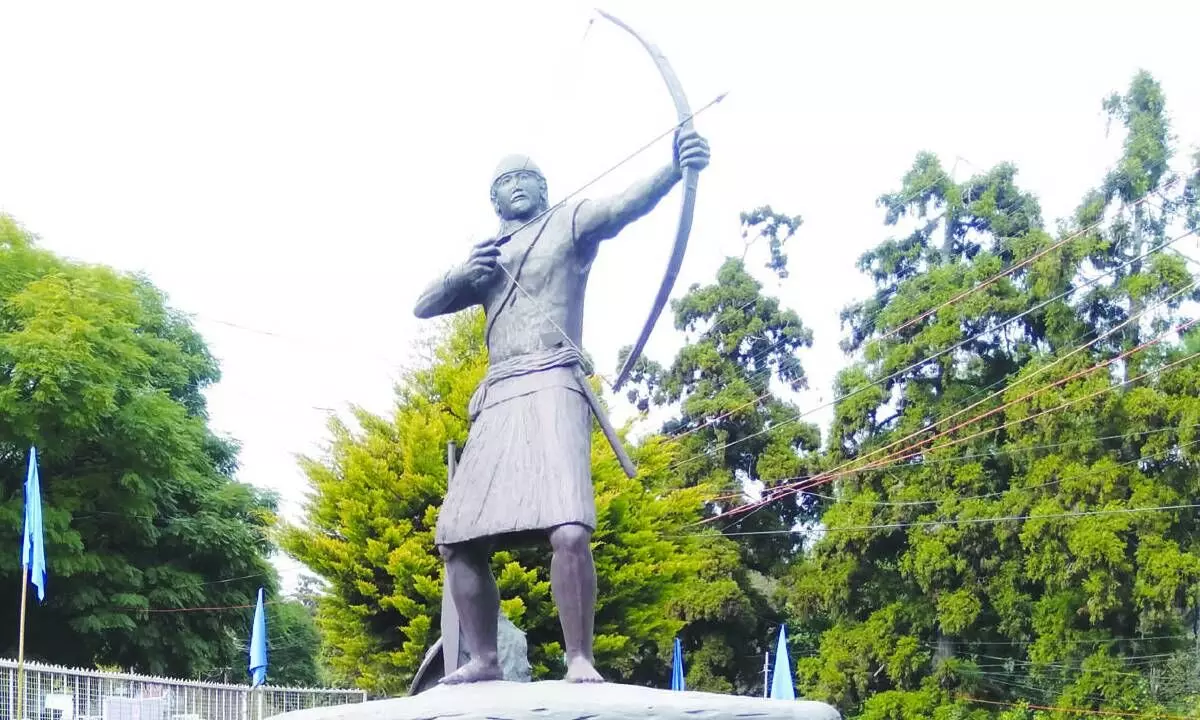Meghalaya people slurring the martyrdom of U Kiang Nangbah during the freedom movement
Meghalaya boasts of a rich historical legacy that is intertwined with India's freedom movement
image for illustrative purpose

Meghalaya, one of the seven sister states of northeast India, which boasts of mountainous terrain interspersed with valleys and highland plateaus, is rich in geological diversity, particularly composed of Archean rock formations. Within these formations lie invaluable mineral deposits, including coal, limestone, uranium and sillimanite. Notable figures like Nobel laureate Gurudev Rabindranath Tagore have been captivated by the state’s natural charm. He has penned historical accounts of his 20 days state at a bungalow known as Brookside, which, incidentally, is now a heritage bungalow in Shillong’s Rilbong locality.
Currently, the Meghalaya government actively utilizes tourism as a vital component of its economic strategy. This fetches around Rs. 1,600 crore every year, especially from a diverse array of tourism offerings, ranging from the state’s stunning natural landscapes to its rich cultural heritage and adventurous activities. To maximize the potential of this sector, the government prioritises infrastructure development, marketing initiatives and sustainable tourism practices.
The substantial revenue underscores the state government's commitment to nurture this key industry.
Meghalaya boasts not only of breathtaking natural beauty but also a rich historical legacy that is intertwined with India's freedom movement. This connection is exemplified by prominent figures such as Shri U Kiang Nongbah in the Jaintia Hills, Shri U Tirot Sing in the Khasi Hills, and Shri Pa Togan Sangma in the Garo Hills. Among them, U Kiang Nongbah stands out as a revolutionary figure who courageously opposed British rule. In 1857, during the First War of Indian Independence, he led an uprising against the British forces, symbolizing the resilience and determination of the people of Meghalaya in their struggle for freedom. His ultimate sacrifice, publicly hanged by the British, signifies the fervour for independence that echoed across Meghalaya. Netaji Subhas Chandra Bose's connection with Shillong, the former capital of Assam, was deeply profound, resonating with the hearts of its people across various social strata. Regardless of tribe, caste, or religion, Netaji's presence in Shillong sparked a surge of admiration and respect among its residents. His charisma and unwavering dedication to the cause of Indian independence inspired a sense of fervent patriotism among the youth of Shillong. Netaji's influence was not merely confined to rhetoric; it instilled a tangible desire for action and participation in the struggle for freedom. His impassioned speeches and resolute leadership captivated the imagination of the youth, compelling many to heed the call to join the fight for India's liberation. The emergence of Meghalaya as a state in 1972, following lengthy negotiations, marked a significant milestone, yet it also ushered in a period of unrest. Anjum Hasan's novel "The Lunatic in My Head," situated in her native Shillong, exemplifies literature's reflection of the socio-political landscape. Within the narrative, characters like Firdaus, Aman, and Sophie are bound together by their shared identity as Dkhars, or "outsiders." Instances of violence, such as the brutal gang rape and lynching of a pregnant woman, expose the darker underbelly of societal tensions, rooted in ethnic and cultural differences. The paradox of historical heroes turning into contemporary perpetrators reflects a disconcerting reality. Individuals who once fought for India's freedom are now inciting discord, demanding an Inner Line Permit (ILP) and resorting to violence against non-tribal residents. The recent spate of killings, including that of Arjun Rai, signifies the urgency for governmental intervention. The analogy drawn between non-tribals in Meghalaya and Kashmiri Pandits highlights the gravity of the situation, emphasizing the vulnerability of marginalized communities amidst escalating tensions. Questions linger regarding the government's efficacy in addressing such atrocities. Calls for the removal of special permissions and stringent measures against perpetrators echo sentiments for peace and justice. The need for swift and decisive action to quell unrest and uphold the principles of inclusivity and harmony remains paramount. Meghalaya's journey, marred by periods of turbulence and conflict, underscores the complexities of identity, politics, and power dynamics. Ensuring a harmonious and equitable future for all residents of Meghalaya requires a concerted effort from both governmental and societal stakeholders. Dialogue, empathy, and collective action are essential in achieving this goal. Failure to prioritize these principles could have significant repercussions, particularly in the tourism sector. The state's appeal to visitors hinges not only on its natural beauty but also on its reputation for inclusivity and social harmony. Moreover, neglecting these values not only affects tourism but also has broader implications for humanity. In a diverse society like Meghalaya, fostering understanding and unity among different communities is crucial for social cohesion and progress. Furthermore, there's a moral imperative to protect and support the marginalized communities within the state.
Failure to do so not only undermine the concept of Vasudeva Kutumbakam (the world is one family) but also tarnishes the pride of Bharat in the eyes of others. It's binding on the more populous communities in Meghalaya to safeguard the rights and well-being of their fellow residents, reflecting the true spirit of unity and compassion.
(The writer is a social worker and General Secretary of Bongo Bhashi Mahasabha Foundation)

